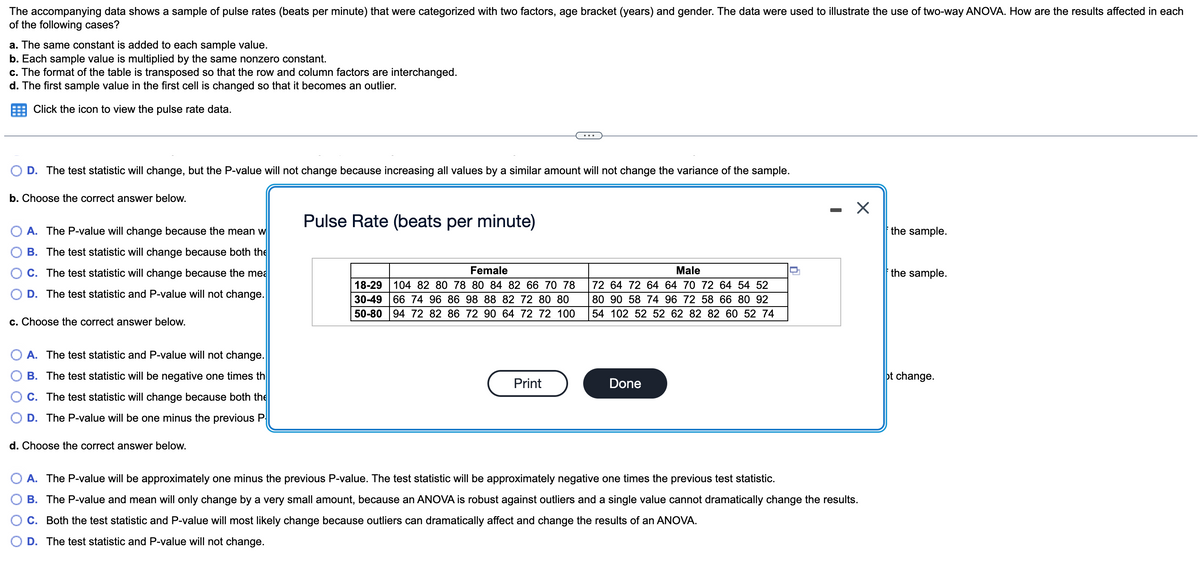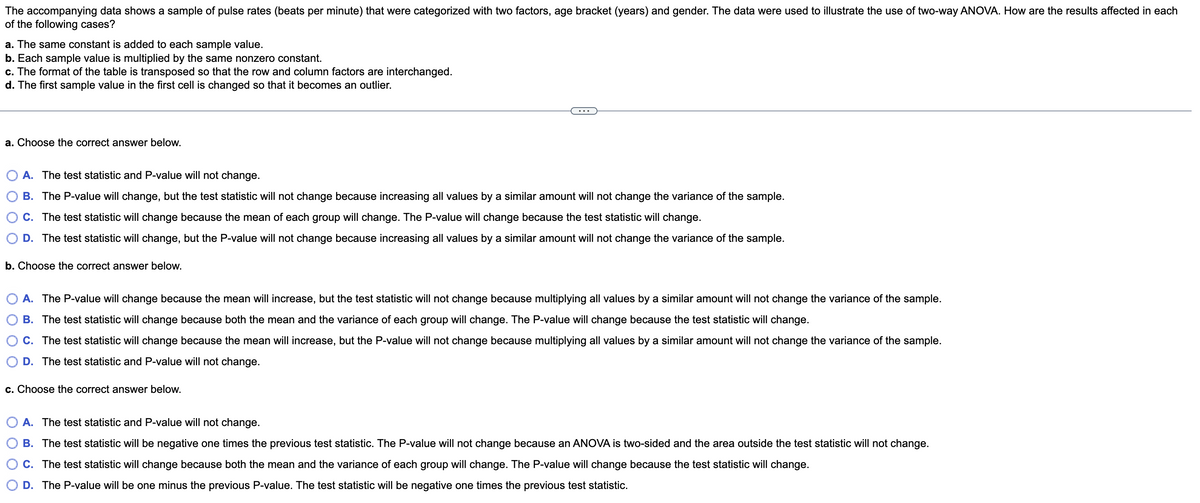The accompanying data shows a sample of pulse rates (beats per minute) that were categorized with two factors, age bracket (years) and gender. The data were used to illustrate the use of two-way ANOVA. How are the results affected in each of the following cases? a. The same constant is added to each sample value. b. Each sample value is multiplied by the same nonzero constant. c. The format of the table is transposed so that the row and column factors are interchanged. d. The first sample value in the first cell is changed so that it becomes an outlier. E Click the icon to view the pulse rate data. O D. The test statistic will change, but the P-value will not change because increasing all values by a similar amount will not change the variance of the sample. b. Choose the correct answer below. - X Pulse Rate (beats per minute) O A. The P-value will change because the mean w the sample. O B. The test statistic will change because both the OC. The test statistic will change because the mea Female Male the sample. 18-29 104 82 80 78 80 84 82 66 70 78 30-49 66 74 96 86 98 88 82 72 80 80 50-80 94 72 82 86 72 90 64 72 72 100|54 102 52 52 62 82 82 60 52 74 72 64 72 64 64 70 72 64 54 52 80 90 58 74 96 72 58 66 80 92 O D. The test statistic and P-value will not change. c. Choose the correct answer below. O A. The test statistic and P-value will not change. O B. The test statistic will be negative one times th ot change. Print Done OC. The test statistic will change because both the O D. The P-value will be one minus the previous P d. Choose the correct answer below. O A. The P-value will be approximately one minus the previous P-value. The test statistic will be approximately negative one times the previous test statistic. O B. The P-value and mean will only change by a very small amount, because an ANOVA is robust against outliers and a single value cannot dramatically change the results. OC. Both the test statistic and P-value will most likely change because outliers can dramatically affect and change the results of an ANOVA. O D. The test statistic and P-value will not change.
The accompanying data shows a sample of pulse rates (beats per minute) that were categorized with two factors, age bracket (years) and gender. The data were used to illustrate the use of two-way ANOVA. How are the results affected in each of the following cases? a. The same constant is added to each sample value. b. Each sample value is multiplied by the same nonzero constant. c. The format of the table is transposed so that the row and column factors are interchanged. d. The first sample value in the first cell is changed so that it becomes an outlier. E Click the icon to view the pulse rate data. O D. The test statistic will change, but the P-value will not change because increasing all values by a similar amount will not change the variance of the sample. b. Choose the correct answer below. - X Pulse Rate (beats per minute) O A. The P-value will change because the mean w the sample. O B. The test statistic will change because both the OC. The test statistic will change because the mea Female Male the sample. 18-29 104 82 80 78 80 84 82 66 70 78 30-49 66 74 96 86 98 88 82 72 80 80 50-80 94 72 82 86 72 90 64 72 72 100|54 102 52 52 62 82 82 60 52 74 72 64 72 64 64 70 72 64 54 52 80 90 58 74 96 72 58 66 80 92 O D. The test statistic and P-value will not change. c. Choose the correct answer below. O A. The test statistic and P-value will not change. O B. The test statistic will be negative one times th ot change. Print Done OC. The test statistic will change because both the O D. The P-value will be one minus the previous P d. Choose the correct answer below. O A. The P-value will be approximately one minus the previous P-value. The test statistic will be approximately negative one times the previous test statistic. O B. The P-value and mean will only change by a very small amount, because an ANOVA is robust against outliers and a single value cannot dramatically change the results. OC. Both the test statistic and P-value will most likely change because outliers can dramatically affect and change the results of an ANOVA. O D. The test statistic and P-value will not change.
College Algebra (MindTap Course List)
12th Edition
ISBN:9781305652231
Author:R. David Gustafson, Jeff Hughes
Publisher:R. David Gustafson, Jeff Hughes
Chapter8: Sequences, Series, And Probability
Section8.7: Probability
Problem 58E: What is meant by the sample space of an experiment?
Related questions
Question
7.
please help a through d.

Transcribed Image Text:The accompanying data shows a sample of pulse rates (beats per minute) that were categorized with two factors, age bracket (years) and gender. The data were used to illustrate the use of two-way ANOVA. How are the results affected in each
of the following cases?
a. The same constant is added to each sample value.
b. Each sample value is multiplied by the same nonzero constant.
c. The format of the table is transposed so that the row and column factors are interchanged.
d. The first sample value in the first cell is changed so that it becomes an outlier.
Click the icon to view the pulse rate data.
D. The test statistic will change, but the P-value will not change because increasing all values by a similar amount will not change the variance of the sample.
b. Choose the correct answer below.
Pulse Rate (beats per minute)
A. The P-value will change because the mean w
the sample.
B. The test statistic will change because both the
C. The test statistic will change because the mea
Female
Male
the sample.
18-29
30-49 |66 74 96 86 98 88 82 72 80 80
50-80 94 72 82 86 72 90 64 72 72 100
104 82 80 78 80 84 82 66 70 78
72 64 72 64 64 70 72 64 54 52
D. The test statistic and P-value will not change.
80 90 58 74 96 72 58 66 80 92
54 102 52 52 62 82 82 60 52 74
c. Choose the correct answer below.
O A. The test statistic and P-value will not change.
B. The test statistic will be negative one times th
ot change.
Print
Done
C. The test statistic will change because both the
D. The P-value will be one minus the previous P
d. Choose the correct answer below.
A. The P-value will be approximately one minus the previous P-value. The test statistic will be approximately negative one times the previous test statistic.
B. The P-value and mean will only change by a very small amount, because an ANOVA is robust against outliers and a single value cannot dramatically change the results.
C. Both the test statistic and P-value will most likely change because outliers can dramatically affect and change the results of an ANOVA.
D. The test statistic and P-value will not change.

Transcribed Image Text:The accompanying data shows a sample of pulse rates (beats per minute) that were categorized with two factors, age bracket (years) and gender. The data were used to illustrate the use of two-way ANOVA. How are the results affected in each
of the following cases?
a. The same constant is added to each sample value.
b. Each sample value is multiplied by the same nonzero constant.
c. The format of the table is transposed so that the row and column factors are interchanged.
d. The first sample value in the first cell is changed so that it becomes an outlier.
a. Choose the correct answer below.
A. The test statistic and P-value will not change.
B. The P-value will change, but the test statistic will not change because increasing all values by a similar amount will not change the variance of the sample.
C. The test statistic will change because the mean of each group will change. The P-value will change because the test statistic will change.
O D. The test statistic will change, but the P-value will not change because increasing all values by a similar amount will not change the variance of the sample.
b. Choose the correct answer below.
O A. The P-value will change because the mean will increase, but the test statistic will not change because multiplying all values by a similar amount will not change the variance of the sample.
B. The test statistic will change because both the mean and the variance of each group will change. The P-value will change because the test statistic will change.
C. The test statistic will change because the mean will increase, but the P-value will not change because multiplying all values by a similar amount will not change the variance of the sample.
D. The test statistic and P-value will not change.
c. Choose the correct answer below.
O A. The test statistic and P-value will not change.
B. The test statistic will be negative one times the previous test statistic. The P-value will not change because an ANOVA is two-sided and the area outside the test statistic will not change.
C. The test statistic will change because both the mean and the variance of each group will change. The P-value will change because the test statistic will change.
O D. The P-value will be one minus the previous P-value. The test statistic will be negative one times the previous test statistic.
Expert Solution
This question has been solved!
Explore an expertly crafted, step-by-step solution for a thorough understanding of key concepts.
This is a popular solution!
Trending now
This is a popular solution!
Step by step
Solved in 4 steps

Recommended textbooks for you

College Algebra (MindTap Course List)
Algebra
ISBN:
9781305652231
Author:
R. David Gustafson, Jeff Hughes
Publisher:
Cengage Learning

College Algebra (MindTap Course List)
Algebra
ISBN:
9781305652231
Author:
R. David Gustafson, Jeff Hughes
Publisher:
Cengage Learning